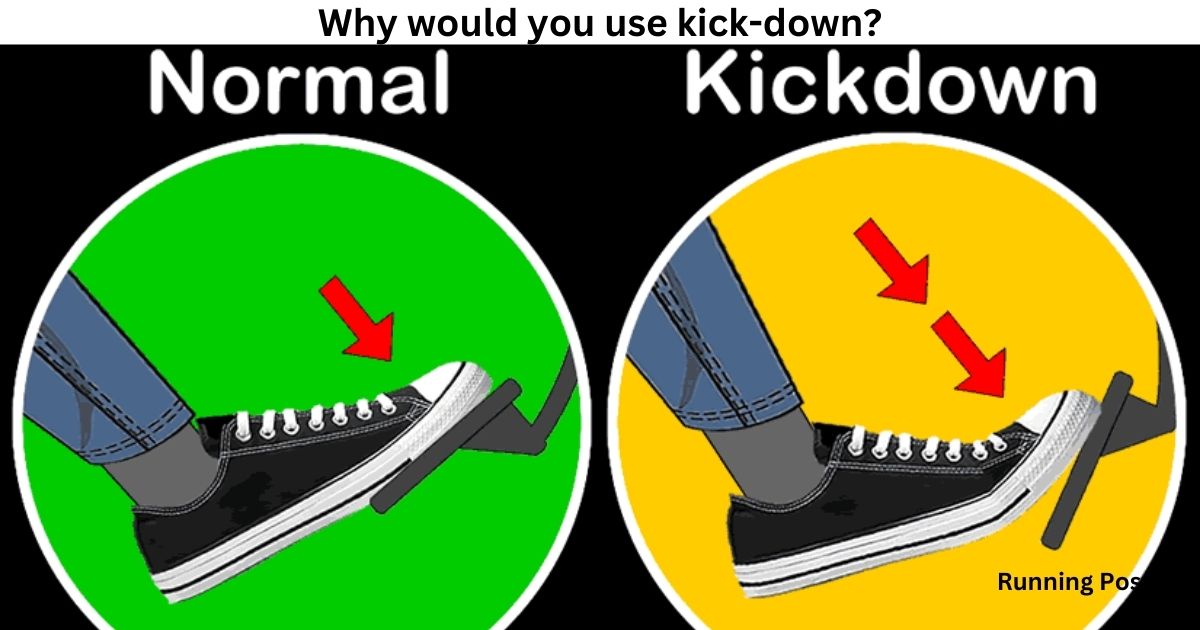| A: To reduce fuel consumption | B: To stop in an emergency | C: To improve acceleration | D: To engage cruise control |
Understanding Kick-Down in Automatic Transmission
Kick-down is a feature in automatic transmissions that allows drivers to temporarily override the standard gear selection for a boost in power. This function is particularly useful when you need a sudden burst of acceleration, such as when overtaking another vehicle or merging onto a highway. In most automatic cars, kick-down is engaged by pressing the accelerator pedal down quickly and fully. When this happens, the transmission automatically shifts to a lower gear, allowing the engine to rev higher and deliver more power to the wheels.
Kick-down is essential because it enables the driver to access the full performance potential of the engine without needing to manually downshift gears. This feature is one of the reasons why automatic transmissions have become so popular among drivers who appreciate the convenience of not having to shift gears manually, yet still want the ability to control the car’s performance in specific situations.
- Kick-down offers immediate acceleration.
- It helps in situations requiring quick power boosts.
- Enhances driving safety by enabling rapid responses.
For most drivers, understanding how kick-down works and when to use it can greatly improve their driving experience, particularly in scenarios where quick, decisive action is required. It also adds a level of control that many drivers appreciate, bridging the gap between the convenience of an automatic transmission and the responsiveness of a manual one.
Why Would You Use Kick-Down?
To Improve Acceleration
Kick-down is primarily used to improve acceleration. When you’re driving an automatic car and you suddenly need to overtake a slower vehicle, merge into fast-moving traffic, or climb a steep hill, kick-down allows the car to drop to a lower gear. This provides the engine with more power and the ability to accelerate rapidly.
Acceleration improvement through kick-down is significant because it allows for a quicker response from the vehicle. This is crucial in scenarios where every second counts, such as overtaking on a two-lane road or merging onto a busy highway. Kick-down gives you the ability to accelerate quickly and safely, reducing the risk of collisions and making your driving experience more controlled and confident.
- Kick-down triggers a rapid downshift for immediate power.
- It’s ideal for overtaking and merging onto highways.
- Provides better control and safety in high-pressure situations.
By using kick-down, drivers can ensure that they have the necessary power when they need it most. This can be the difference between safely overtaking another vehicle or struggling to do so with the risk of not completing the maneuver in time.
The Purpose of Kick-Down in Automatic Cars
Kick-down serves several key purposes in an automatic car, all of which contribute to a smoother and more responsive driving experience. One of the primary purposes of kick-down is to give drivers the ability to quickly access the maximum power of the engine without having to manually downshift gears. This is particularly important in situations where rapid acceleration is required.
Kick-down also plays a vital role in maintaining the safety and efficiency of driving. By allowing the transmission to drop to a lower gear instantly, it ensures that the vehicle can accelerate faster when necessary, which is crucial in avoiding potential hazards on the road. This can be especially important when merging onto a highway or when needing to quickly change lanes in busy traffic.
- Kick-down enhances the driving dynamics of an automatic car.
- It ensures the vehicle is always in the correct gear for rapid acceleration.
- Improves safety by allowing for quick reactions to changing road conditions.
In essence, kick-down provides a seamless way for drivers to take full control of their vehicle’s performance without sacrificing the convenience of an automatic transmission. It bridges the gap between automatic and manual transmissions, offering the best of both worlds.
How to Engage Kick-Down in an Automatic Transmission

Steps to Kick-Down
Engaging kick-down in an automatic transmission is straightforward. Here’s a step-by-step guide on how to do it:
- Press the Accelerator Fully: To engage kick-down, you need to press the accelerator pedal all the way to the floor. This action sends a signal to the transmission to drop to a lower gear, allowing for a rapid increase in engine RPMs and providing the needed acceleration.
- Feel the Gear Shift: Once you press the accelerator fully, you should feel the transmission downshift almost immediately. This change in gears is accompanied by an increase in engine noise as the RPMs rise.
- Maintain Control: As the vehicle accelerates, maintain control by keeping your hands firmly on the steering wheel. The car may lurch forward slightly as the power increases, so be prepared for this sudden surge.
- Release the Pedal Gradually: After achieving the desired speed, gradually release the accelerator pedal. The transmission will automatically shift back to a higher gear once you ease off the pedal, returning the vehicle to its regular driving mode.
- Kick-down is easy to engage with full throttle application.
- It provides immediate power and response from the vehicle.
- The transmission automatically returns to higher gears as acceleration needs decrease.
Understanding how to properly engage kick-down is crucial for making the most of this feature. It ensures that you can access the power you need when you need it, while still maintaining control over your vehicle.
Selecting Lower Gears in Automatic Cars
When and Why You Might Need to Select a Lower Gear
Selecting lower gears in an automatic car might seem unnecessary, but there are specific scenarios where it can be beneficial. While the vehicle’s computer usually manages gear selection efficiently, certain situations may require manual intervention. For example, when driving downhill, selecting a lower gear helps control speed without overusing the brakes, which can prevent brake wear and overheating.
Another scenario is when driving through mountainous terrain. In these conditions, selecting a lower gear helps the car maintain power and prevent the engine from struggling. It also provides better control when ascending or descending steep grades. Moreover, lower gears are useful in heavy traffic or when towing, as they provide more power and control at lower speeds.
- Lower gears offer better control in downhill driving.
- They prevent engine strain and provide more power in tough terrain.
- Useful in situations like towing or driving in heavy traffic.
Even though automatic transmissions are designed to handle most driving situations, knowing when and why to manually select a lower gear can improve your driving safety and efficiency.
You Also Like It:
Where Would It Be Unsafe to Overtake?
What’s Most Likely to Waste Fuel?
When must you contact the Driver and Vehicle Licensing Agency (DVLA)?
Kick-Down vs. Manual Gear Selection
Comparing Kick-Down with Manual Downshifting
Kick-down and manual gear selection serve similar purposes but in different ways. Kick-down is an automatic feature that temporarily shifts the car to a lower gear when the accelerator is fully pressed. This is done quickly and without driver intervention, providing instant acceleration.
On the other hand, manual gear selection involves the driver manually selecting a lower gear using the gear lever or paddle shifters. This provides more control over the vehicle’s gear selection, allowing the driver to choose the exact gear based on the driving conditions.
- Kick-down is automatic and offers instant response.
- Manual gear selection provides more precise control.
- Both methods have their pros and cons depending on the situation.
Kick-down is ideal for situations requiring quick, temporary acceleration, while manual gear selection is better for sustained control, such as driving on steep hills or in challenging road conditions.
Conclusion: The Importance of Kick-Down in Automatic Transmissions
Recap of the Key Benefits of Kick-Down
Kick-down is a valuable feature in automatic transmissions that enhances both performance and safety. By allowing the vehicle to quickly downshift and access additional power, kick-down helps drivers navigate challenging driving situations with confidence.
- Kick-down provides instant power when needed.
- It enhances safety by improving the vehicle’s responsiveness.
- Useful in various driving scenarios, from overtaking to hill climbing.
Understanding how and when to use kick-down can make a significant difference in your driving experience, offering a balance of convenience and control that is highly beneficial in today’s driving environment.
FAQs: Understanding Kick-Down in Automatic Transmission
Q1: What is kick-down in an automatic transmission?
A1: Kick-down is a feature in automatic transmissions that temporarily shifts the vehicle to a lower gear when the accelerator is fully pressed. This provides a sudden boost in power for rapid acceleration.
Q2: How does kick-down work?
A2: Kick-down works by sending a signal to the transmission to downshift when the accelerator pedal is pressed to the floor. This increases engine RPMs and provides more power to the wheels.
Q3: Is kick-down available in all automatic cars?
A3: Most modern automatic cars are equipped with a kick-down feature, but it’s always best to check your vehicle’s manual to confirm its availability and functionality.
You Also Like It:
how i sleep at night knowing l’m failing all my cl – tymoff
Releated Posts
MAB Instructor Certification: Your Gateway to Professional Crisis Management Leadership
In today’s fast-evolving professional environments—especially in healthcare, mental health, education, and corrections—conflict and aggression can arise without warning.…
Freewayget.com: Your Ultimate Platform for Deals, Discounts, and Digital Products
Introduction to Freewayget.com In today’s fast-paced digital world, finding reliable platforms that offer authentic discounts, deals, and digital…
Affordable & Fast Embroidery Digitizing Services in Your Area
Embroidery digitizing services provide corporations, designers, and people with brilliant embroidery-equipped designs by means of changing art work…
Introduction to hdhub4u nit
In this article, we will delve into the details of hdhub4u nit, exploring its features, benefits, and why…

















